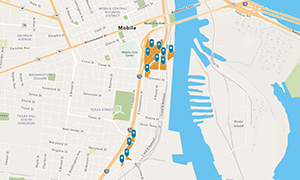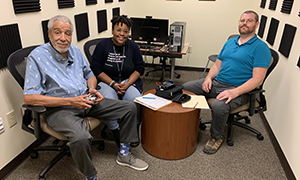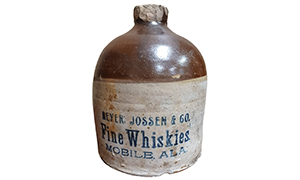I-10 Mobile River Bridge Archaeology Project
The I-10 Mobile River Bridge (MRB) Archaeology Project is the biggest project conducted by the Center for Archaeological Studies. We excavated 15 sites along the new I-10 Mobile River Bridge route from November 2021- June 2023 in partnership with Wiregrass Archaeological Consulting. These sites span the entire history of Mobile Bay, ranging from Native American occupations from 2,000 years ago to the homes, businesses, and waterfront industries of the last 300 years. The Down the Bay Oral History Project, conducted by the McCall Library Oral History Team, includes over 100 interviews with community members to record a more recent story of the neighborhood. Together, these data sources tell a more complete history of the Mobile Bay area.
Video Gallery
Learn More About the Project
Press Highlights
Our work for the I-10 Project was featured by multiple news outlets. Check out some of the highlights!
- Mobile Bay Magazine “Digging Deep” (June 20, 2023)
- Gulf Coast Media “Archeologists dig through 2,000 years of history before I-10 bridge construction begins in Mobile” (November 17, 2022)
- Alabama Public Radio “The history of Mobile--underfoot!” (September 8, 2022)
- Currents Magazine "Digging Deeper" (Spring 2025)
Downloads
Project Partners
The I-10 MRB Archaeology project is interdisciplinary and includes artists, educators, geographers, geologists, historians, oral historians, and others. Archaeologists from the Center for Archaeological Studies and Wiregrass Archaeological Consulting excavated the 15 sites in the field and continue to analyze artifacts in the lab. Our historical researchers are providing insights into past lifeways through maps, city directories, census data, and other documents. Oral historians from the Doy Leale McCall Rare Book and Manuscript Library and the African-American Studies program conducted over 100 interviews with community members from Down the Bay to understand the recent history of the neighborhood.
The I-10 Mobile River Bridge and Bayway project is conducted by the Alabama Department of Transportation and the Federal Highway Administration in cooperation with the U.S. Army Corps of Engineers and the U.S. Coast Guard. The project also involves input from Native American Tribes, the Advisory Council on Historic Preservation, the Alabama Historical Commission, and local governments and historical organizations.









